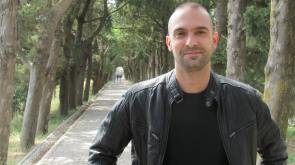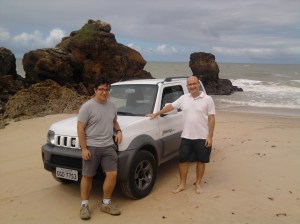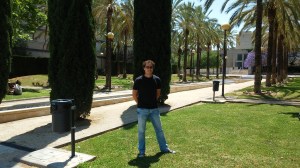It has been revealed that we are living on the edge of vacuum instability by the discovery of Higgs particle at the Large Hadron Collider since 2012. The determination of Higgs mass finally provides the last-missed parameter, the Higgs self coupling, to be 0.12 in the Standard Model of particle physics after nearly half century of its foundation. This value completes the initial conditions for a set of differential equations, called renormalization group (RG) equations, which govern how particles interact at very high energy scales. It turns out that the self coupling can vanish or even become negative at the Planck scale, where the quantum gravity effects become significant. We note for later reference that the Yukawa coupling between the Higgs and top quark plays a crucial role to reduce the Higgs self coupling in its RG evolution. The Higgs potential is about to become Continue reading
Monthly Archives: June 2016
Book review: Covariant Loop Quantum Gravity, an elementary introduction to quantum gravity and spinfoam theory
Review of “Covariant Loop Quantum Gravity, an elementary introduction to quantum gravity and spinfoam theory” by Carlo Rovelli and Francesca Vidotto
One of the central problems of contemporary physics is finding a theory that allows for describing the quantum behavior of the gravitational field. This book is a remarkable update on one of the most promising approaches for the treatment of this problem: loop quantum gravity. It places special emphasis on the covariant techniques, which provide with a definition of the path integral, an approach known as spin foams. It is a field that has undergone quite a bit of development in the last two decades. The book gives an overview of this area, discussing a series of results that are presented with great clarity. Both students and established researchers will benefit from the book, which provides a dependable introduction and reference material for further studies. Only a basic knowledge of general relativity, quantum mechanics and quantum field theory is assumed. The conceptual aspects and key ideas are discussed in the main body of the book and Continue reading
Evolution of the Universe Through Soft Singularities

Dr Vasilis K. Oikonomou is a researcher in Tomsk State Pedagogical University and in the Laboratory for Theoretical Cosmology in Tomsk State University of Control Systems and Radioelectronics (TUSUR) in Tomsk Russia. His research interests are focused on inflationary and bouncing cosmology, modified gravity, supersymmetric quantum systems, mathematical physics and epistemic game theory.
Describing the correct Universe evolution is one of the challenges in modern theoretical cosmology. The vital features of a correct Universe evolution are the successful description of early and late-time acceleration and also the intermediate eras, the radiation and matter domination eras. With our recently published CQG paper entitled ‘’ Singular cosmology unifying early and late-time acceleration with matter and radiation domination era’’, the author and Prof. Sergei Odintsov provided an F(R) gravity description of all the evolution eras in an unified way.
The primordial curvature perturbations are so relevant today for current observations since these capture the information about the primordial Universe at the time inflation took place. During the Continue reading
Wormholes can fix black holes

Diego Rubiera-Garcia (left, Lisbon University) and Gonzalo J. Olmo (right, University of Valencia – CSIC) after crossing a wormhole that connects Europe with the beaches of the Brazilian Northeast.
According to Einstein’s theory of general relativity (GR), black holes are ferocious beasts able to swallow and destroy everything within their reach. Their strong gravitational pull deforms the space-time causal structure in such a way that nothing can get out of them once their event horizon is crossed. The fate of those incautious observers curious enough to cross this border is to suffer a painful spaghettification process due to the strong tidal forces before being destroyed at the center of the black hole.

Antonio Sanchez-Puente (University of Valencia – CSIC) enjoying a sunny day in Valencia after submitting yet another postdoc application.
For a theoretical physicist, the suffering of observers is admissible (one might even consider it part of an experimentalist’s job) but their total destruction is not. The destruction of observers (and light signals) is determined by the fact that the affine parameter of their word-line (its geodesic) stops at the center of the black hole. Their clocks no longer tick and, therefore, there is no way for them to exchange or acquire new information. This implies the breakdown of the predictability of the laws of physics because physical measurements are no longer possible at that point. For this reason, when a space-time has incomplete geodesics — word-lines whose affine parameter does not cover the whole real line — we say that it is singular.
In order to overcome the conceptual problems raised by singularities, a careful analysis of what causes the destruction of observers is necessary. Our intuition may get satisfied by blaming the enormous tidal forces near the center, but the problem is much subtler. This is precisely what we explore in our paper. Continue reading
How do we know LIGO detected gravitational waves?
The practical challenges of characterizing the Advanced LIGO detectors.

This CQG+ piece is brought to you by experts in the LIGO detector characterisation group (Detchar)
Comics by Nutsinee Kijbunchoo
The Advanced LIGO gravitational wave detectors are extremely sensitive instruments, measuring almost impossibly small changes in length. Their sensitivity is equivalent to measuring a change in distance the thickness of a human hair between Earth and Alpha Centauri, the closest star to Earth. Naturally, such a sensitive measurement picks up background noise in the form of disturbances that pollute the signal. For example, we might expect to see wind gusts, lightning strikes, earthquakes, or four buses full of middle schoolers rolling down the driveway to appear in the data as noise.
How then can we be sure LIGO really detected a Continue reading



You must be logged in to post a comment.